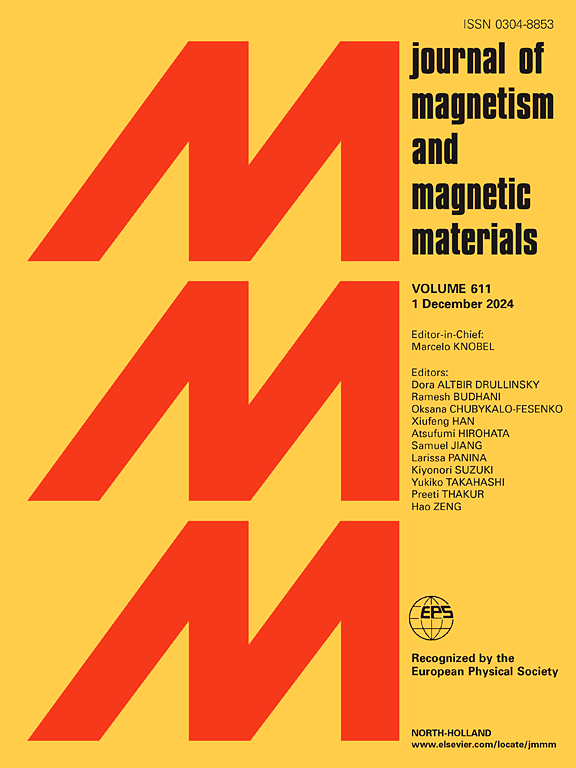单磁性24价电子全heusler合金化学无序效应的机器学习研究
IF 2.5
3区 材料科学
Q3 MATERIALS SCIENCE, MULTIDISCIPLINARY
引用次数: 0
摘要
大多数full-Heusler合金表现出B2或BCC等无序结构,而不是理想的有序L21或XA结构。迫切需要探索这些材料的磁性与化学无序性之间的内在关系。在这项研究中,我们结合第一性原理计算和机器学习方法来研究化学无序对24价电子x2yz型合金磁性的影响。通过筛选含有磁性元素的稳定化合物,我们构建了一个多维特征集。利用梯度增强机和随机森林分别建立分类模型和回归模型。结果表明,X或Y是否为磁性元件,无序程度是决定其磁性能的关键因素。使用该方案,我们成功地预测了三种未研究的化合物(fe2hfsn, Fe2YSb和co2lias)的磁性,与从头计算相比,R2值高达0.97。本文章由计算机程序翻译,如有差异,请以英文原文为准。

Machine learning investigation of chemical disorder effects in 24-valence-electron full-Heusler alloys with single magnetic element
Most full-Heusler alloys exhibit disordered structures such as B2 or BCC, rather than the ideal ordered or XA structures. It is urgent to explore the intrinsic relationship between magnetism and chemical disorder in these materials. In this study, we combine first-principles calculations and machine learning methods to investigate the influence of chemical disorder on the magnetism of 24-valence-electron XYZ-type alloys. By screening stable compounds containing magnetic elements, we constructed a multidimensional feature set. The gradient boosting machine and random forest were used to establish classification and regression models, respectively. The results indicate that whether X or Y is a magnetic element, the degree of disorder is a key factor determining their magnetic properties. Using the proposed scheme, we successfully predict the magnetic properties of three unstudied compounds—FeHfSn, FeYSb, and CoLiAs—achieving an value as high as 0.97, compared to calculations.
求助全文
通过发布文献求助,成功后即可免费获取论文全文。
去求助
来源期刊

Journal of Magnetism and Magnetic Materials
物理-材料科学:综合
CiteScore
5.30
自引率
11.10%
发文量
1149
审稿时长
59 days
期刊介绍:
The Journal of Magnetism and Magnetic Materials provides an important forum for the disclosure and discussion of original contributions covering the whole spectrum of topics, from basic magnetism to the technology and applications of magnetic materials. The journal encourages greater interaction between the basic and applied sub-disciplines of magnetism with comprehensive review articles, in addition to full-length contributions. In addition, other categories of contributions are welcome, including Critical Focused issues, Current Perspectives and Outreach to the General Public.
Main Categories:
Full-length articles:
Technically original research documents that report results of value to the communities that comprise the journal audience. The link between chemical, structural and microstructural properties on the one hand and magnetic properties on the other hand are encouraged.
In addition to general topics covering all areas of magnetism and magnetic materials, the full-length articles also include three sub-sections, focusing on Nanomagnetism, Spintronics and Applications.
The sub-section on Nanomagnetism contains articles on magnetic nanoparticles, nanowires, thin films, 2D materials and other nanoscale magnetic materials and their applications.
The sub-section on Spintronics contains articles on magnetoresistance, magnetoimpedance, magneto-optical phenomena, Micro-Electro-Mechanical Systems (MEMS), and other topics related to spin current control and magneto-transport phenomena. The sub-section on Applications display papers that focus on applications of magnetic materials. The applications need to show a connection to magnetism.
Review articles:
Review articles organize, clarify, and summarize existing major works in the areas covered by the Journal and provide comprehensive citations to the full spectrum of relevant literature.
 求助内容:
求助内容: 应助结果提醒方式:
应助结果提醒方式:


